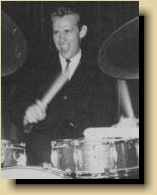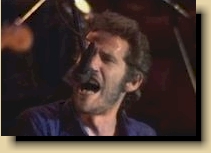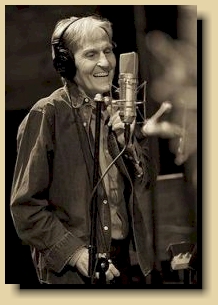|
Levon Helm Was in the right place at the right time.
He saw the birth of rock and roll and though he was too
much of a gentleman to say it, his role in helping to
keep that rebellious child healthy was more than just
instrumental.
On May 26, 1940, Mark Lavon Helm was the second of four
children born to Nell and Diamond Helm in Elaine,
Arkansas. Diamond was a cotton farmer who entertained
occasionally as a musician. The Helm’s loved music and
often sang together. They listened to The Grand Ole Opry
and Sonny Boy Williamson and his King Biscuit
Entertainers regularly on the radio. A favorite family
pastime was attending traveling music shows in the area.
According to his 1993 autobiography, This Wheel’s On
Fire, Levon recalled seeing his first live show, Bill
Monroe and his Blue Grass Boys, at six years old. His
description: “This really tattooed my brain. I’ve never
forgotten it.” Hearing performers like Monroe and
Williamson on the radio was one thing, seeing them live
made a huge impression.
Levon’s father bought him his first guitar at age nine.
At ten and eleven, whenever he wasn't in school or at
work on the farm, the boy could be found at KFFA’s
broadcasting studio in Helena, Arkansas, watching Sonny
Boy Williamson do his radio show, King Biscuit Time.
Helm made his younger sister Linda a string bass out of
a washtub when he was twelve years old. She would play
the bass while her brother slapped his thighs and played
harmonica and guitar. They would sing songs learned at
home and popular hits of the day, and billed themselves
as “Lavon and Linda.” Because of their fresh faced good
looks, obvious musical talent and Levon’s natural
ability to win an audience with sheer personality and
infectious rhythms, the pair consistently won talent
contests along the Arkansas 4-H Club circuit.
In
1954, Levon was fourteen years old when he saw Johnny
Cash and Carl Perkins do a show at Helena. Also
performing was a young Elvis Presley with Scotty Moore
on guitar, and Bill Black on stand-up bass. They did not
have a drummer. The music was early jazz-fueled
rockabilly, and the audience went wild. In ’55 he saw
Elvis once more, before Presley’s star exploded. This
time Presley had D.J. Fontana with him on drums and Bill
Black was playing electric bass. Helm couldn’t get over
the difference and thought it was the best band he’d
seen. The added instruments gave the music solidity and
depth. People jumped out of their seats dancing to the
thunderous, heart-pumping, rhythms. The melting pot that
was the Mississippi Delta had boiled over and evolved.
It’s magnificently rich blues was uniting with all the
powerful, new, spicy-hot sounds and textures that became
rock and roll.
Natural progression led Levon to
form his own rock band as a high school junior, called
The Jungle Bush Beaters. While Little Richard and Jerry
Lee Lewis were making teens everywhere crazed, Levon
would practice, play, watch and learn. After seeing
Jerry Lee’s drummer Jimmy Van Eaton, he seriously began
thinking of playing the drums himself. Around this same
time, the seventeen year old musician was invited by
Conway Twitty to share the stage with Twitty and his
Rock Housers. He had met Twitty when "Lavon and Linda"
opened for him at a previous show. Helm was a
personable, polite teen who took his music seriously, so
Twitty allowed him to sit in whenever the opportunity
arose.
 Ronnie
Hawkins came into Levon Helm’s life in 1957. A
charismatic entertainer and front-man, Hawkins was
gathering musicians to tour Canada where the shows and
money were steady. Ronnie had a sharp eye for talent. He
needed a drummer and Levon fit the bill. Fulfilling a
promise to Nell and Diamond to finish high school, Levon
joined Ronnie and his “Hawks” on the road. The young
Arkansas farm boy, once a tractor driving champion,
found himself driving Hawkins' Cadillac to gigs, happily
aware that all the unknown adventures of rock and roll
would soon be his destiny. Ronnie
Hawkins came into Levon Helm’s life in 1957. A
charismatic entertainer and front-man, Hawkins was
gathering musicians to tour Canada where the shows and
money were steady. Ronnie had a sharp eye for talent. He
needed a drummer and Levon fit the bill. Fulfilling a
promise to Nell and Diamond to finish high school, Levon
joined Ronnie and his “Hawks” on the road. The young
Arkansas farm boy, once a tractor driving champion,
found himself driving Hawkins' Cadillac to gigs, happily
aware that all the unknown adventures of rock and roll
would soon be his destiny.
In ’59 Ronnie got The Hawks signed to Roulette
Records. They had two hits, Forty Days and
Mary Lou, sold 750,000 copies and appeared on Dick
Clark’s American Bandstand.
Hawkins and Helm recruited four more talented
Canadian musicians in the early sixties, Richard Manuel,
Rick Danko, Garth Hudson and Robbie Robertson. Under
Ronnie’s tutelage they would often perform until
midnight and rehearse until four in the morning. Other
bands began emulating their style, now they were the
ones to watch and learn from.
Eventually, the students surpassed their teacher.
Weary of Ronnie’s strict regulations, and eager to
expand their own musical interests, the five decided to
break from Hawkins. They called themselves “Levon and
the Hawks.”
About 1965, Bob Dylan decided to
change his sound. He was ready to “go electric” and
wanted Levon and The Hawks to help him fire it up. The
boys signed on to tour with Dylan but unfortunately
Dylan’s die-hard folk fans resisted. Night after night
of constant booing left Levon without the pleasure of
seeing his audience enjoy themselves. He called his
drummer’s stool “the best seat in the house,” because he
could see his fellow musicians and his audience
simultaneously. What pleased him most, always, was that
his audience had a good time. He temporarily left the
group and eventually landed back home in Arkansas. Dylan
and the rest of the band took up residence in Woodstock,
N.Y. They rented a large, pink house where they wrote
and rehearsed new material. Danko called for Helm to
join them when Capitol Records gave them a recording
contract.
 Woodstock
residents called them “the band,” so they kept the
moniker. The name “The Band” fit. The sound was no
frills rock and roll but far from simplistic. They fused
every musical influence they were exposed to over the
years as individuals and as a unit. The result was
brilliant. Their development as musicians was perfected
by years of playing. Living together at “Big Pink”
allowed complete collaboration of their artistic
expression. Americana and folklore themes,
heart-wrenching ballads filled with naked emotion,
majestic harmonies, hard driving rhythms, and exquisite
instrumentation made critics, peers and fans realize
that this music was unlike any heard before. Their first
album,
Music from Big Pink, released in July of 1968,
made them household names and as a result they were
invited to appear on the Ed Sullivan Show in autumn of
’69. Following Big Pink’s success the next album,
called simply The Band, is considered by some as
their masterpiece. They made seven albums total,
including one live recording in 1972, Rock of Ages.
Many of their hits such as The Weight, W.S.
Walcott’s Medicine Show, and The Night They Drove
Old
Dixie Down, were spawned from stories of Levon’s
beloved south. Woodstock
residents called them “the band,” so they kept the
moniker. The name “The Band” fit. The sound was no
frills rock and roll but far from simplistic. They fused
every musical influence they were exposed to over the
years as individuals and as a unit. The result was
brilliant. Their development as musicians was perfected
by years of playing. Living together at “Big Pink”
allowed complete collaboration of their artistic
expression. Americana and folklore themes,
heart-wrenching ballads filled with naked emotion,
majestic harmonies, hard driving rhythms, and exquisite
instrumentation made critics, peers and fans realize
that this music was unlike any heard before. Their first
album,
Music from Big Pink, released in July of 1968,
made them household names and as a result they were
invited to appear on the Ed Sullivan Show in autumn of
’69. Following Big Pink’s success the next album,
called simply The Band, is considered by some as
their masterpiece. They made seven albums total,
including one live recording in 1972, Rock of Ages.
Many of their hits such as The Weight, W.S.
Walcott’s Medicine Show, and The Night They Drove
Old
Dixie Down, were spawned from stories of Levon’s
beloved south.
Helm was working in Los Angeles in
’74, at a Sunset Blvd. hotel when he spotted a beautiful
young brunette taking a dip in the pool. Her name was
Sandra Dodd and when she looked up at him smiling, she
didn’t recognize him at first. The charming musician
offered to take the lovely lady for sushi and never
looked back. They were married on September 7, 1981 in
Woodstock.
The barn and studio Helm built in
Woodstock, which became his permanent home, was just
about complete in 1975. He invited Muddy Waters to his
new studio and they recorded
Muddy Waters in Woodstock. To the delight of
everyone involved, it won a Grammy.
The Band held
a farewell concert at Winterland in San Francisco on
Thanksgiving 1976. It was a bittersweet time for many
who felt the group’s demise was too soon. They called it
The Last Waltz which included Ronnie Hawkins, Dr.
John, Muddy Waters, Ringo Starr, Bob Dylan, Eric Clapton
and an all-star guest list of peers and friends that
read like the "Who’s Who" of rock and roll. The event
eventually sold as a triple album and was also filmed,
becoming the first historical “rockumentary.”
Group members went on to individual pursuits. Levon cut
his debut album The RCO All-Stars, in 1977. His
next effort was the self-titled Levon Helm,
followed by American Son,
released in 1980. That same year was pivotal as Helm
turned his attention to acting. He played Loretta Lynn’s
father in
Coal Miner’s Daughter, winning great
reviews for his first film appearance. He did another
self-titled album and Hollywood again came knocking in
’83 giving Helm a role in
The Right Stuff. The authenticity he brought to
his characters earned him numerous movie roles from 1980
until 2009. Levon gave a sensitive, convincing portrayal
of a destitute blind man in the 2005 Tommy Lee Jones'
vehicle, The
Three Burials of Melquiades Estrada. In 2007, he
filmed
Shooter with Mark Wahlberg. His last role was in
2009. where he portrayed Confederate General John Bell
Hood in a movie called In the Electric Mist,
again with his friend Tommy Lee Jones.
Rick Danko and Levon reunited to play music
after Danko had been living in California. Rick moved
back to Woodstock and the friends did an acoustic tour
in early ’83. In San Jose the following year, they
received excellent reviews when Hudson and Manuel joined
them for their first U.S. appearance as The Band since
1976. They continued playing together until the tragic
death of their dear friend and comrade, the forty-two
year old Manuel.
During the 90’s three more Band
albums were recorded.
Jericho, High on the Hog, ending with
Jubilation. In 1998, Levon was diagnosed with throat
cancer and the famous voice with the rich southern
nuances was silenced to a whisper. He still played the
drums, mandolin and harmonica, often performing with his
daughter, Amy Helm, also a vocalist and instrumentalist.
A great emotional support to her father during this
time, Amy appeared with him regularly at Levon Helm
Studios. In 1999, Helm endured another tragic loss when
Rick Danko passed away nineteen days before his fifty
sixth birthday. His death marked the end of an era.
 Miraculously,
Levon's voice slowly returned. He felt comfortable
enough to sing again live. With imagination and vision,
he conceived The Midnight Ramble Sessions, a series of
live performances at Levon Helm Studios in Woodstock.
Named for the traveling minstrel shows of his youth, the
first Midnight Ramble was held in January, 2004. It
featured one of the last performances by great blues
pianist, Johnnie Johnson. Friends old and new joined
Levon on his stage including: Emmylou Harris, Dr. John,
John Sebastian, Allan Toussaint, Elvis Costello, Phil
Lesh, Jimmy Vivino, Hubert Sumlin, Little Sammy Davis,
Billy Bob Thornton and The Boxmasters, The Muddy Waters
Band, The Swell Season, Donald Fagen, Steve Jordon, Hot
Tuna, Kris Kristofferson, The Black Crows, The Nitty
Gritty Dirt Band, Norah Jones, The Bacon Brothers,
Robbie Dupree, My Morning Jacket, Shemekia Copeland, The
Wood Brothers, Steve Earle, Jackie Greene, Sam Bush,
Brewer & Shipley, Carolyn Wonderland, Ollabelle, and The
Alexis P. Suter Band. The monthly Rambles at "The Barn,"
were wildly successful drawing a world wide audience. Miraculously,
Levon's voice slowly returned. He felt comfortable
enough to sing again live. With imagination and vision,
he conceived The Midnight Ramble Sessions, a series of
live performances at Levon Helm Studios in Woodstock.
Named for the traveling minstrel shows of his youth, the
first Midnight Ramble was held in January, 2004. It
featured one of the last performances by great blues
pianist, Johnnie Johnson. Friends old and new joined
Levon on his stage including: Emmylou Harris, Dr. John,
John Sebastian, Allan Toussaint, Elvis Costello, Phil
Lesh, Jimmy Vivino, Hubert Sumlin, Little Sammy Davis,
Billy Bob Thornton and The Boxmasters, The Muddy Waters
Band, The Swell Season, Donald Fagen, Steve Jordon, Hot
Tuna, Kris Kristofferson, The Black Crows, The Nitty
Gritty Dirt Band, Norah Jones, The Bacon Brothers,
Robbie Dupree, My Morning Jacket, Shemekia Copeland, The
Wood Brothers, Steve Earle, Jackie Greene, Sam Bush,
Brewer & Shipley, Carolyn Wonderland, Ollabelle, and The
Alexis P. Suter Band. The monthly Rambles at "The Barn,"
were wildly successful drawing a world wide audience.
Releases produced by Levon Helm Studios from Helm's
personal "vault," were Volume I and II of The
Midnight Ramble Sessions, plus a live RCO
All-Stars performance from New Year’s Eve 1977, at
the Palladium. The vitality and magnetism of these
recordings speak for themselves. In September of 2007,
Dirt Farmer Music and Vanguard Records released Dirt
Farmer, Levon's first solo, studio album in
twenty-five years. A project particularly close to his
heart, the CD contains music reminiscent of his past,
and songs handed down from his parents. Dirt Farmer
was awarded a Grammy for Best Traditional Folk Album in
February 2008 and landed Levon a spot in Rolling
Stone’s The 100 Greatest Singers of All Time.
That same year he was also recognized by the Recording
Academy with a lifetime achievement award as an original
member of The Band and was given the “Artist of the
Year” Award by the Americana Music Association. In 2009,
Levon released Electric Dirt which marked his
highest debut in Soundscan era at #36 and spent six
consecutive weeks at #1 on the Americana Radio Chart. He
won a second Grammy for Electric Dirt in the
inaugural category of Best Americana Album in 2010. In
September 2008, Levon took
The Midnight Ramble on the road to Nashville's
historic Ryman Auditorium. Buddy Miller, John Hiatt,
Sheryl Crow, George Receli, Sam Bush and Billy Bob
Thornton helped The Levon Helm Band create an evening of
unforgettable musical joy. Ramble at the Ryman - Live
CD and DVD,
(sold individually), won him his third consecutive
Grammy, again as Best Album in the Americana category,
in February 2012. Sadly, Levon's cancer returned shortly
after this last triumph. He passed away on April 19,
2012. His funeral was a tearful, joyful, musical
celebration of his life.
The
intimacy of the shows performed at Levon’s hearth
offered a hospitality and warmth found in no other
venue, not to mention the excellence of the performances
themselves, hosted by a man whose gifts were truly
legendary. Though always an enthusiastic and passionate
performer, with sheer joy and gratitude, he effortlessly
captivated his audience, young and old, with a rhythmic
power all his own. During a career that spanned over
five decades, Levon Helm nurtured a tradition of
professionalism with a deep respect for his craft and
remained refreshingly genuine in a world that often
compromised integrity. He was a master storyteller who
wove his tales with the magic thread of universality
that ties us all. He beckoned us to come in, sit awhile
and enjoy. We see ourselves in his stories and we are
home.
--Dawn LoBue
Authorized by Levon Helm
Copyright © 2006 ~ 2017 All Rights
Reserved.
 |